Lights Over Lapland has a brand-new website full of exciting adventures in Abisko National Park, Sweden! Take a look at our aurora activities and book your once-in-a-lifetime trip with us today! | | |
A NEW SUNSPOT: Breaking a string of 24 spotless days, a new sunspot is growing near the center of the solar disk. Here it is. Amateur astronomers with backyard solar telescopes are encouraged to monitor its development. After all, sunspot genesis is rare during solar minimum. Free: Aurora Alerts
AMATEUR ASTRONOMERS FIND A BRIGHT NEW COMET: There's a new comet in the morning sky. Discovered just last week by three amateur astronomers--one in Arizona and two in Japan--Comet Machholz-Fujikawa-Iwamoto (C/2018 V1) has quadrupled in brightness over the past few days. "It is now glowing like a fuzzy 8th magnitude star in the constellation Virgo," reports Michael Jäger of Turmkogel, Austria, who photographed it on Nov. 11th:
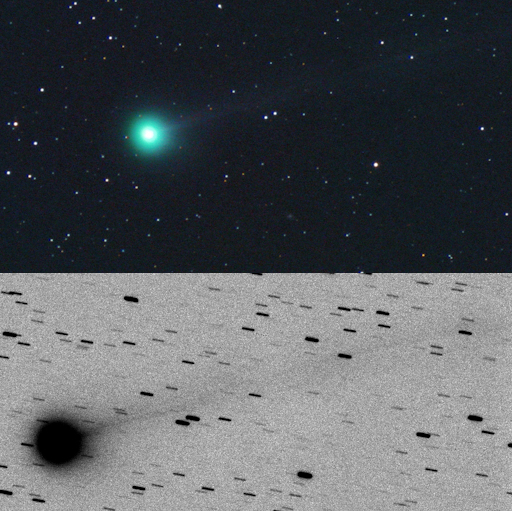
"The discovery of a comet by amateur astronomers is a rare event nowadays because robotic Near-Earth-Object search programs usually catch them first," he says. "My special congratulations to the three discoverers."
Comet Machholz-Fujikawa-Iwamoto appears to be a first-time visitor to the inner solar system. It is plunging toward the sun on nearly-parabolic orbit that will take it just inside the orbit of Mercury. Closest approach to the sun (0.38 AU) is on Dec. 3-4; closest approach to Earth (0.67 AU) is Nov. 27th.
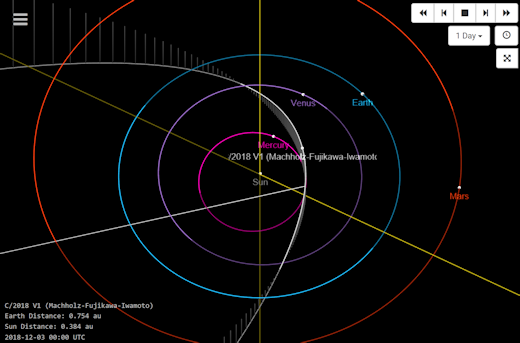
Click to view the comet's 3D orbit
Fresh comets like this one are notoriously unpredictable. They can surge in brightness, seeming to promise a spectacular display, when suddenly they fizzle as fragile deposits of ice are exhausted by solar heat. No one knows if Comet Machholz-Fujikawa-Iwamoto will even become a naked eye object. At the moment it is an easy target for backyard telescopes with the promise of ... unpredictability. Stay tuned!
Resources: 3D Orbit; Ephemeris; Orbital Elements; Sky Maps.
Realtime Comet Photo Gallery
A GIFT FROM THE EDGE OF SPACE: Are you looking for a far-out Christmas gift? Nothing says "I love you" like a moonstone from the edge of space. The students of Earth to Sky Calculus flew this moonstone wrapped in a hand-crafted sterling silver Celtic love knot 35.1 km (115,158 feet) above Earth's surface:
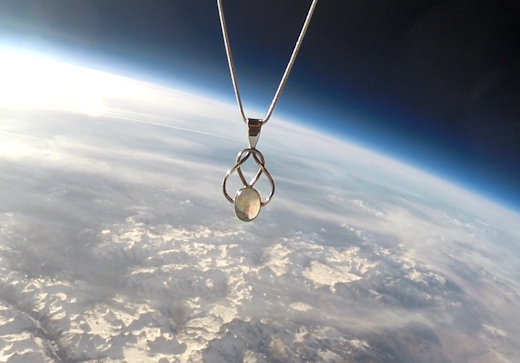
You can have it for $179.95. The students are selling these pendants to support their cosmic ray ballooning program. Each one comes with a greeting card showing the item in flight and telling the story of its journey to the edge of space. All sales support the Earth to Sky Calculus cosmic ray ballooning program and hands-on STEM research.
Far Out Gifts: Earth to Sky Store
All sales support hands-on STEM education
AURORAS IN THE SHAPE OF A PHOENIX: Solar wind is blowing around Earth faster than 600 km/s. Last night, the onrushing gas sparked auroras over Norway in the shape of a Phoenix:
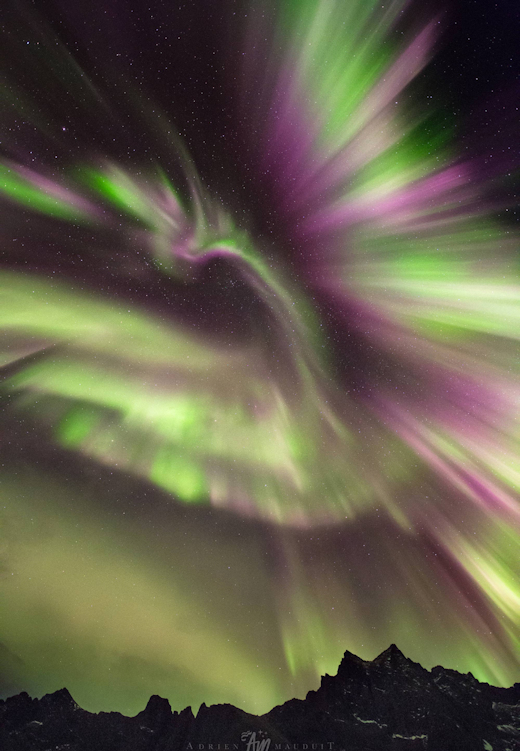
"The aurora show over Senja, Norway, on Nov. 11th was nothing short of magical," reports photographer Adrien Mauduit. "During one outburst of lights, this image appeared. Huge colorful pillars took the shape of a fiery bird."
According to mythology, the Phoenix dies in an outburst of colorful flame, then rises again. Indeed, the bird could return to the Arctic Circle on Nov. 12th as the solar wind continues to blow. Stay tuned. Free: Aurora Alerts.
Realtime Aurora Photo Gallery
TREMORS IN EARTH'S MAGNETIC FIELD: Solar wind flowing from a hole in the sun's atmosphere has been buffeting Earth's magnetic field since Nov. 9th. Stuart Green detected the tremors from his private magnetic observatory in Preston, Lancashire, UK:
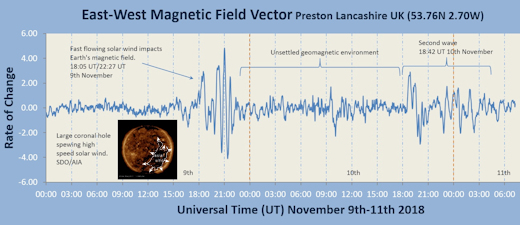
"The solar wind delivered a double blow, moving magnetometer needles around the globe," reports Green. "The first wave arrived on November 9th at approximately 18:00 UT and lasted for 4.5 hrs. The second wave arrived almost 24 hrs later. It was less geoeffective than the first, although no less spectacular according to the beautiful images of the aurora being submitted to Spaceweather.com."
The squiggles in Green's chart represent changes in his local magnetic field. "The sensor is buried in my garden about 0.5 meters below the surface in an East/West orientation," he explains. "This allows very sensitive (sub nanotesla) measurements of magnetic declination during geomagnetic storms. The plot shows the change in magnetic flux density in nanotesla occurring between readings every few minutes."
Realtime Space Weather Photo Gallery
Every night, a network of
NASA all-sky cameras scans the skies above the United States for meteoritic fireballs. Automated software maintained by NASA's Meteoroid Environment Office calculates their orbits, velocity, penetration depth in Earth's atmosphere and many other characteristics. Daily results are presented here on Spaceweather.com.
On Nov. 12, 2018, the network reported 19 fireballs.
(17 sporadics, 2 Northern Taurids)

In this diagram of the inner solar system, all of the fireball orbits intersect at a single point--Earth. The orbits are color-coded by velocity, from slow (red) to fast (blue). [Larger image] [movies]
Potentially Hazardous Asteroids (
PHAs) are space rocks larger than approximately 100m that can come closer to Earth than 0.05 AU. None of the known PHAs is on a collision course with our planet, although astronomers are finding
new ones all the time.
On November 12, 2018 there were 1936 potentially hazardous asteroids.
 |
Recent & Upcoming Earth-asteroid encounters: | Asteroid | Date(UT) | Miss Distance | Velocity (km/s) | Diameter (m) |
| 2018 VO5 | 2018-Nov-06 | 0.4 LD | 12.2 | 16 |
| 2018 VB5 | 2018-Nov-06 | 16.7 LD | 4.9 | 19 |
| 2018 VW | 2018-Nov-06 | 15.4 LD | 13 | 64 |
| 2018 VN1 | 2018-Nov-06 | 8.7 LD | 5.2 | 21 |
| 2018 VU5 | 2018-Nov-06 | 7.9 LD | 10.1 | 21 |
| 2018 VB7 | 2018-Nov-07 | 15.5 LD | 7 | 37 |
| 2018 VP6 | 2018-Nov-07 | 7.8 LD | 12.2 | 16 |
| 2010 VQ | 2018-Nov-07 | 15.6 LD | 3.8 | 10 |
| 2018 VS6 | 2018-Nov-08 | 1.5 LD | 11.8 | 15 |
| 2018 VA2 | 2018-Nov-09 | 1.9 LD | 6.7 | 14 |
| 2018 VG6 | 2018-Nov-09 | 15.8 LD | 5.5 | 18 |
| 2018 VV4 | 2018-Nov-09 | 6.3 LD | 10.6 | 18 |
| 2018 VR3 | 2018-Nov-09 | 1.9 LD | 8.2 | 15 |
| 2018 VS4 | 2018-Nov-09 | 14.7 LD | 10.1 | 26 |
| 2018 VM6 | 2018-Nov-10 | 9.3 LD | 16.6 | 96 |
| 2018 VD5 | 2018-Nov-10 | 4.5 LD | 9.4 | 9 |
| 2018 VS1 | 2018-Nov-10 | 3.6 LD | 10.6 | 17 |
| 2018 VR1 | 2018-Nov-10 | 13.2 LD | 9.3 | 18 |
| 2018 VX1 | 2018-Nov-10 | 1 LD | 6.1 | 11 |
| 2018 VY4 | 2018-Nov-11 | 5.5 LD | 12.6 | 14 |
| 2018 VH5 | 2018-Nov-11 | 6 LD | 6 | 13 |
| 2018 VA4 | 2018-Nov-11 | 3.1 LD | 7.4 | 8 |
| 2018 VZ6 | 2018-Nov-12 | 9.5 LD | 10.3 | 27 |
| 2018 VN6 | 2018-Nov-12 | 1.9 LD | 14.2 | 8 |
| 2018 VC7 | 2018-Nov-13 | 0.9 LD | 4.5 | 12 |
| 2018 VR6 | 2018-Nov-13 | 8 LD | 9.5 | 12 |
| 2018 VF5 | 2018-Nov-13 | 9.7 LD | 6.8 | 11 |
| 2018 UQ1 | 2018-Nov-13 | 9.4 LD | 12.3 | 146 |
| 2018 VO3 | 2018-Nov-14 | 4.1 LD | 7.7 | 14 |
| 2018 VX5 | 2018-Nov-14 | 3.6 LD | 8.3 | 25 |
| 2018 VK1 | 2018-Nov-14 | 10.2 LD | 2.3 | 12 |
| 2018 VW4 | 2018-Nov-14 | 9.8 LD | 12.5 | 45 |
| 2018 VD7 | 2018-Nov-14 | 9.1 LD | 11 | 26 |
| 2007 UL12 | 2018-Nov-15 | 16.4 LD | 25.8 | 235 |
| 2018 VT4 | 2018-Nov-18 | 11.1 LD | 4.4 | 18 |
| 2018 VQ6 | 2018-Nov-20 | 11.4 LD | 7.9 | 22 |
| 2009 WB105 | 2018-Nov-25 | 15.2 LD | 18.9 | 71 |
| 2008 WD14 | 2018-Nov-27 | 7.4 LD | 9.3 | 93 |
| 2001 WO15 | 2018-Nov-28 | 13.6 LD | 11.7 | 107 |
| 2018 VE4 | 2018-Nov-30 | 15.1 LD | 4.8 | 30 |
| 2018 TG6 | 2018-Dec-02 | 3.9 LD | 1.4 | 12 |
| 2013 VX4 | 2018-Dec-09 | 4.1 LD | 6.6 | 65 |
| 2018 VX6 | 2018-Dec-10 | 16.6 LD | 11.2 | 71 |
| 2015 XX169 | 2018-Dec-13 | 17 LD | 5.8 | 12 |
| 2017 XQ60 | 2018-Dec-21 | 11.3 LD | 15.6 | 47 |
| 163899 | 2018-Dec-22 | 7.4 LD | 6.2 | 1232 |
| 418849 | 2018-Dec-23 | 16.6 LD | 17.6 | 269 |
| 2014 AD16 | 2019-Jan-04 | 12.9 LD | 9.4 | 12 |
| 2016 AZ8 | 2019-Jan-07 | 11.6 LD | 9.1 | 224 |
| 2013 YM2 | 2019-Jan-09 | 7.3 LD | 4.3 | 20 |
Notes: LD means "Lunar Distance." 1 LD = 384,401 km, the distance between Earth and the Moon. 1 LD also equals 0.00256 AU. MAG is the visual magnitude of the asteroid on the date of closest approach. | | Cosmic Rays in the Atmosphere |
SOMETHING NEW! We have developed a new predictive model of aviation radiation. It's called E-RAD--short for Empirical RADiation model. We are constantly flying radiation sensors onboard airplanes over the US and and around the world, so far collecting more than 22,000 gps-tagged radiation measurements. Using this unique dataset, we can predict the dosage on any flight over the USA with an error no worse than 15%.
E-RAD lets us do something new: Every day we monitor approximately 1400 flights criss-crossing the 10 busiest routes in the continental USA. Typically, this includes more than 80,000 passengers per day. E-RAD calculates the radiation exposure for every single flight.
The Hot Flights Table is a daily summary of these calculations. It shows the 5 charter flights with the highest dose rates; the 5 commercial flights with the highest dose rates; 5 commercial flights with near-average dose rates; and the 5 commercial flights with the lowest dose rates. Passengers typically experience dose rates that are 20 to 70 times higher than natural radiation at sea level.
To measure radiation on airplanes, we use the same sensors we fly to the stratosphere onboard Earth to Sky Calculus cosmic ray balloons: neutron bubble chambers and X-ray/gamma-ray Geiger tubes sensitive to energies between 10 keV and 20 MeV. These energies span the range of medical X-ray machines and airport security scanners.
Column definitions: (1) The flight number; (2) The maximum dose rate during the flight, expressed in units of natural radiation at sea level; (3) The maximum altitude of the plane in feet above sea level; (4) Departure city; (5) Arrival city; (6) Duration of the flight.
SPACE WEATHER BALLOON DATA: Approximately once a week, Spaceweather.com and the students of Earth to Sky Calculus fly space weather balloons to the stratosphere over California. These balloons are equipped with radiation sensors that detect cosmic rays, a surprisingly "down to Earth" form of space weather. Cosmic rays can seed clouds, trigger lightning, and penetrate commercial airplanes. Furthermore, there are studies ( #1, #2, #3, #4) linking cosmic rays with cardiac arrhythmias and sudden cardiac death in the general population. Our latest measurements show that cosmic rays are intensifying, with an increase of more than 18% since 2015:
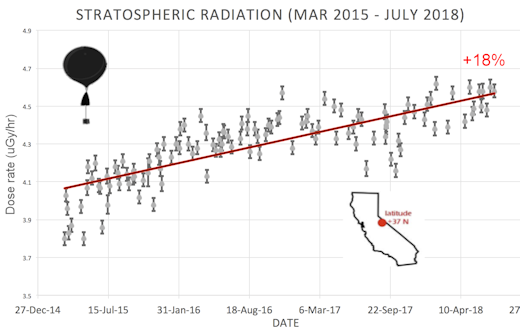
The data points in the graph above correspond to the peak of the Reneger-Pfotzer maximum, which lies about 67,000 feet above central California. When cosmic rays crash into Earth's atmosphere, they produce a spray of secondary particles that is most intense at the entrance to the stratosphere. Physicists Eric Reneger and Georg Pfotzer discovered the maximum using balloons in the 1930s and it is what we are measuring today.
En route to the stratosphere, our sensors also pass through aviation altitudes:

In this plot, dose rates are expessed as multiples of sea level. For instance, we see that boarding a plane that flies at 25,000 feet exposes passengers to dose rates ~10x higher than sea level. At 40,000 feet, the multiplier is closer to 50x.
The radiation sensors onboard our helium balloons detect X-rays and gamma-rays in the energy range 10 keV to 20 MeV. These energies span the range of medical X-ray machines and airport security scanners.
Why are cosmic rays intensifying? The main reason is the sun. Solar storm clouds such as coronal mass ejections (CMEs) sweep aside cosmic rays when they pass by Earth. During Solar Maximum, CMEs are abundant and cosmic rays are held at bay. Now, however, the solar cycle is swinging toward Solar Minimum, allowing cosmic rays to return. Another reason could be the weakening of Earth's magnetic field, which helps protect us from deep-space radiation.
| | The official U.S. government space weather bureau |
| | The first place to look for information about sundogs, pillars, rainbows and related phenomena. |
| | Researchers call it a "Hubble for the sun." SDO is the most advanced solar observatory ever. |
| | 3D views of the sun from NASA's Solar and Terrestrial Relations Observatory |
| | Realtime and archival images of the Sun from SOHO. |
| | from the NOAA Space Environment Center |
| | fun to read, but should be taken with a grain of salt! Forecasts looking ahead more than a few days are often wrong. |
| | from the NOAA Space Environment Center |
| | the underlying science of space weather |
 | If you are a Youtuber and want to buy real Youtube views than try out Buyrealsocial.com for the best results possible! |
 | To find reviews of new online casino sites in the UK try The Casino DB where there are hundreds of online casino reviews complete with bonuses and ratings. Looking for a new online casino? Try Casimpo the new site dedicated to making online casino simple and easy for all. |
| | These links help Spaceweather.com stay online. Thank you to our supporters! |
| | | | | | |

